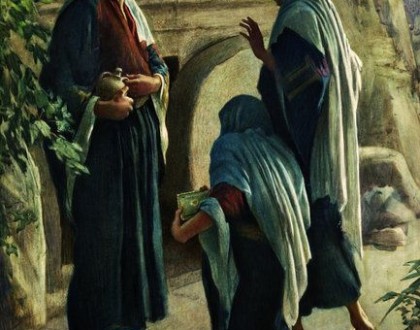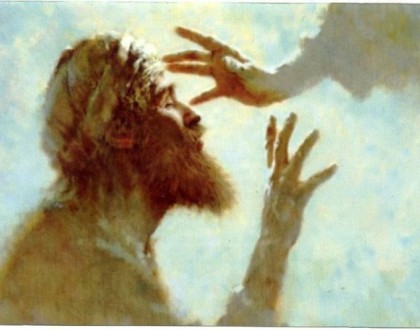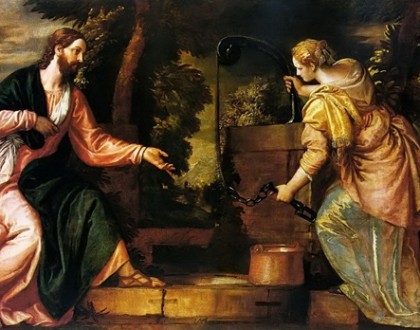The Assumption of Mary
The Assumption of Mary
In the 1st reading today, taken from the book of Revelation (Apocalypse), we are taken right into the heavenly court, into the realm of God. We see the celestial temple open, and within it we can spy the Ark of the Covenant. All this can seem quite alien to us, (the Indiana Jones movies re-introduced us to the ark of the covenant) but if you are a 1st Century Jew reading this text, all this would have extremely powerful overtones. The Ark, was the box that contained the remnants of the 10 commandments, it was the raison d’être for the temple, it’s why the temple existed is to house the Ark of the Covenant, it was the object found within the holy of holies, at the very heart of the temple. It bore the divine presence to Israel, that’s not too strong a term to use.
Before the temple of Solomon was built the ark was carried into battle by the Israelite armies when they went out against their enemies. It’s symbolized and bore God’s presence and power. When Israel lost the ark as it did on a couple of occasions, it lost its way. When it was definitively lost during the Babylonian invasion, it broke Israel’s heart.(That’s what the movie is about, the lost Ark, and people speculate about where it might be. And Israel in some ways still longs for the Ark of the Covenant. However, in the book of Revelation the Ark is now back in its proper place, its now in the heavenly temple, but here’s the difference, it’s associated with a Woman who is about to give birth.
“A great sign appeared in the sky…”
That image is associated with the image of the Ark, now how come? Because the early Church saw Mary, the Mother of Jesus as the new and definitive ark, why? Because she carried within her in the most vivid way not just the remnants of the 10 Commandments, she carried within her the very personal presence of God. That’s why in the gothic churches you will often see an association between Mary and the Ark, In Notre dame in Paris its over the left Porto as you go in, those images are associated with each other.
The New Ark Mary is like the old Ark, associated with battle. As she is about to give birth, the woman is confronted by a dragon.
“Then another sign appeared in the sky. A huge red dragon….”
This is not a sentimental image at all. This is a pretty hard-edged image. Here is the woman, associated with the ark, the bearer of the divine presence, but from the moment she is about to give birth she is confronted by a terrible enemy. What does the Dragon stand for? Perhaps Rome? Maybe the 7 heads are evocative of the Seven Hills of Rome. At the time this book was written, Rome was the great earthly power. It stands for Rome and all of Rome’s antecedents, all these forms of worldly power, which are predicated upon violence and oppression. Isn’t that often the way it works, the powers of the world to the present day, rely upon oppression and the threat of violence. But here’s the message of the book of Revelation; This fearsome Dragon, imagine it with its 7 heads and the horns, and the crowns and so on… imagine you are the father of a child and your wife is about to give birth, and outside the hospital room there is this terrible beast, that’s the image we are meant to have.
But this dragon is powerless against the woman and child.
“She gave birth to a son, a male child destined to rule over …”
This little child and its mother are more powerful than the most powerful of all the worlds’ armies. All of its political might, what’s the point?
The Ark of the Covenant, Mary the new Ark is still effective in battle, as it was in ancient Israel; the Ark of the Covenant is still brought out when Israel does battle with its enemies.
With the entire in mind, those powerful images and associations, turn to the Gospel, which takes us not to the heavenly court and the cosmic struggle, but takes us rather to a little town, in the hill country of Judah. That means the area around Jerusalem in the south. Where a woman is greeting her cousin, when Elizabeth heard Mary’s greeting, the infant leaped in her womb. And Elizabeth filled with the Holy Spirit, cried out in a loud voice and said, blessed are you among women, and blessed is the fruit of your womb.
What is Elizabeth acknowledging? That the Ark of the Covenant has come into her house. And has blessed it. That lovely detail of the infant John the Baptist, leaping in his mother’s womb. He is like David who leaped and danced in the presence of the Ark of the Covenant, as it was brought into Jerusalem. David the warrior now is ringing that ark into his Holy City. And he dances before it. And here is John the Baptist, the new David figure, dancing before the Ark.
Now listen now how Mary confirms this interpretation herself through very marshal language. There is nothing sentimental about this scene either.
Mary says; “He has shown the strength of his arm, he scattered the proud in their conceit, he has cast down the mighty from their throne, and has lifted up the lowly. He has filled the hungry and the rich he has sent away empty“”.
What does Mary know? She knows that this child who she is bearing, will confront the powers of the world. He will confront those who et themselves up in pride. Those who dare to sit on High thrones and lord it over the humble. She knows he will lift up the lowly, that he will feed those who have been exploited.
Whatever power it may be, this child will defeat them. You see what she is announcing in this wonderful magnificat. My soul doth magnify the lord”… Mary is announcing herself as the true ark that he knew Israel will successfully carry into battle. What she speaks here are quite literally fighting words.
What does all this have to do with our feast day? The feast of the Assumption of the Virgin. Well go back to the 1st reading and you’ll see. The Assumption, is Mary’s translation into the realm of God. Her elevation, body and soul, into heaven where she now reigns.
Don’t think of this in platonic manner, we are often misled in that manner, the escape of the soul from the body. That’s what Plato thought was the whole point of life. But not biblical people, they want the resurrection of the body. We look for the restoration of the whole self, in this higher realm that we call heaven. Mary now reigns as a queen. Again don’t sentimentalize that. We say Mary is the queen of heaven. We mean she is now in this higher realm of existence. Where se can exercise infinitely greater power than she exercise when she walked the hills of Judea. Mary was this figure who lived in our world, in space and time, but now through the Assumption, she is the Ark of the Covenant in the heavenly temple, and this makes her a very powerful warrior indeed.
The power exercised by Christ, Mary, the saints, the church is not worldly power. We are not taking on the worldly powers on their own terms. Fighting fire with fire. No, we overwhelm them with the power of the spirit. Mary is the queen of this heavenly realm.
Think of Mary’s apparitions at Lourdes, Tepyac, Fatima… Mary is anything but a coying and sentimental figure. Rather she consistently presents herself as a warrior. She often announces a new stage in the great struggle.
Fatima, she announced this Great War which would indeed preoccupy the people of the 20th century. The war against Russian communism. She announces a new stage in the battle and her new engagement in that struggle. And Mary is always giving us by the way, the weapons to fight, fasting. Prayer, penitence, the rosary. In the eyes of the world what does all this mean. Say that to a worldly power I’m going to battle you with fasting ! Prayer etc.. Well tell the successors of Lenis and Stalin, these are precisely the weapons that did bring them down.
Today’s feast is a celebration of Mary’s passing into the realm of glory but also a call to battle, a spur to battle.
Recent Sermons

Easter Sunday – The Resurrection
April 14, 2017

4th Sunday of Lent Year A – The Man Born Blind
March 27, 2017

3rd Sunday of Lent Year A – The Samaritan Woman at the Well
March 20, 2017





